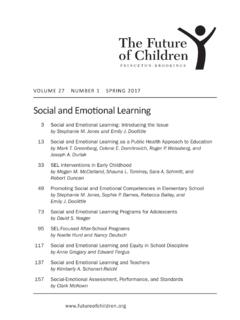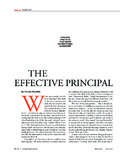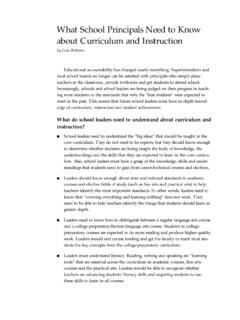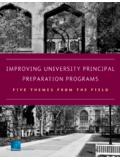Transcription of The Three Essentials - wallacefoundation.org
1 Three Essentials : Improving Schools Requires District Vision, District andState Support, and PrincipalLeadershipAugust 2010 LEARNING-CENTEREDLEADERSHIPPROGRAMThis report was developed by Gene Bottoms, SREB senior vice president, and Jon Schmidt-Davis,research and evaluation specialist for school and leadership research and the publication are supported by the Wallace Foundation, which seeks to support andshare effective ideas and practices that expand learning and enrichment opportunities for all people. The foundation s Three current objectives are to 1) strengthen education leadership to improve studentachievement; 2) improve out-of-school learning opportunities; and 3) expand participation in arts andculture. In pursuit of these goals, Wallace supports the development of knowledge and analysis from multiple sources and differing perspectives. The findings and recommendations of individual reports aresolely those of the authors. For more information and research on these and other related topics, pleasevisit Wallace s Knowledge Center at all the talk about the building principal s key role in producing turnaround high schools, onecritical factor often gets lost in the policy shuffle:Districts vision and actions of system leaders and school board members frequently determine whetherprincipals can be effective in leading school improvement.
2 Districts cannot necessarily make weak principals succeed, but we have seen too many districts create conditions in which even good principalsare likely to fail. And states matter, the point of intervention with struggling schools, whether states opt to bypass the central office ordecide instead to include district leaders in their capacity-building efforts will more often than not determine whether their intervention efforts have much staying Three EssentialsThese understandings about the Three Essentials of school improvement have emerged from closeobservations of the inner workings of seven school districts, as the Southern Regional Education Board s(SREB) Learning-Centered Leadership Program sought to answer this essential question: What are the conditions school districts can create that make it possible for principals to be more effective inleading school improvement?This research is part of a comprehensive effort to pinpoint the key leadership factors that improvestudent achievement and increase the number of high school graduates who are ready for college andcareers.
3 In this study, SREB examined the role of the district office in providing principals with the working conditions they need to improve teacher effectiveness and student performance in the middlegrades and high investigation included 35 interviews with superintendents, school board chairs and selected central-office leaders from seven diverse school systems in Three SREB states. The research design wasshaped in part by earlier SREB studies that analyzed principals perceptions of the support they receivefrom higher up in the school governance structure. Executive SummaryiiThe findings in this report include two overarching conclusions:First: Three essential elements must be in place for struggling high schools to improve in substantive ways: State capacity-building District vision Principal leadershipSecond: These elements are rarely all present and working in a result, despite federal mandates, state interventions and system expenditures of millions of dollars earmarked for reform, many school districts serving high-needs students have a substantial percentage of schools not meeting Adequate Yearly Progress (AYP) goals under the federal No Child LeftBehind Act.
4 What Is MissingPlainly put, the problem is this: Districts and states are failing to create the conditions that make itpossible for principals to lead school improvement happens instead? In some districts, administrators attempt to exert complete control over everyphase of instruction and school operations. They try to own all the problems and enforce all solutionsfrom the top down. In other districts, administrators turn all the problems over to the principal, offeringlittle or no sense of direction or support just a demand for results. Five of the seven districts studied fell into one of these two categories. In the two highly supportivedistricts, however, district and school board leaders exhibited a clear vision of what constitutes a goodschool and have created a framework in which the principal has autonomy to work with faculty on animprovement agenda with collaborative support from the principals have the capacity to rise above a school district s lack of vision and clear purpose.
5 If district leaders cannot see beyond test-prep if they expend most of the system s time, attention and energy on getting kids to pass low-level tests and meet minimum standards then even the mostcapable principals will likely find themselves trapped in caretaker roles, presiding over schools and faculties that lack the direction, the goals and the belief in themselves necessary to create a powerfullearning experience for all their State s Essential JobWhile districts must create the right vision and support system for school improvement, they cannotbe expected to act alone in this effort. State departments of education must build capacity, helping localdistricts develop a coherent vision for the future of their schools, as well as the knowledge and skills tosupport principals and teachers as they create their own vision and goals at the school level and thenhold themselves accountable for need to take a hard look at how they fix broken schools. Under federal pressure to overhaul struggling schools through aggressive intervention, state education leaders tend to assume a triage outlook, concentrating their capacity-building efforts on saving the individual school and not addressingthe chronic problems of the host system.
6 This is a bit like performing a heart bypass and ignoring the systemic causes of the clogged arteries. The patient will improve for a time, but the underlying the intervention setting, it is the state educator s job to create the leadership capacity necessary toreach and sustain higher levels of performance wherever that capacity is lacking. In most districts whereschools continually struggle, improved capacity is needed both at the school level and among centraloffice administrators, school board members and key community leaders. As long as a school district remains dysfunctional, fixed schools will not stay fixed for long. Statesmust focus on building the district s ability to articulate a strategic plan and vision that includes systemgoals, a framework of best practices, supportive policies and a smart alignment of resources. Most important of all, states must prepare district leaders with the knowledge and skills to build a similarcapacity among their principals and teachers.
7 The District s Essential JobThe district including the school board, the superintendent, key staff and influential stakeholdersin the community must have the capacity to develop and articulate both a vision and a set of practicesthat send a clear message of what schools are to be about. This is a message not only for educators, but forthe community at large. This message creates public understanding of what the school system is trying to do to prepare more middle grades students for challenging high school work and to graduate more students from high school prepared for the next step. The authenticity of this message is affirmed through the district s development of a strategic plan thatmanifests the vision and then by district actions that establish the conditions necessary for principalsand teacher leaders to create a different kind of school. These conditions include aligning all policies andresources to the plan; creating a collaborative and supportive working relationship with each school;expecting and supporting the principal to become the school s instructional leader; and communicatingthe vision and strategic plan to the public in a highly visible way that provides the context for principalsto make decisions supported by parents and the larger School s Essential JobThe principal and teacher leaders within each school must engage the faculty and develop a vision of what the school must do if it is to graduate more students who are prepared for life and work in the21st century.
8 If state and district leaders have done their jobs, if the vision and desired outcomes are clear and the necessary supports are in place, then the principal and teachers can begin to design andimplement solutions tailored to the unique needs of their own students and communities. Two decadesof SREB research supports effective practices that include relevant, rigorous, hands-on learning activitiesand programs to ensure that every student is connected with a goal and an adult who will serve as his orher mentor and these conditions, principals can be given a broader range of autonomy to make decisionswithin the boundaries of a strategic framework and to have control over the schedule and placement offaculty within the school. With the vision, framework and supports in place, the principal can be heldaccountable for working with staff to develop an improvement plan within the boundaries that the district has established, while the district provides support for professional development that can be customized to each school.
9 Ownership of problems shifts from the district to the building level, with the district staff supporting the school in creating and implementing the interventions at the school level. The empowered principal becomes directly responsible for engaging the faculty in creating a comprehensive school improvement plan, for fidelity in implementing that plan and, ultimately, forimproving Action on the Three EssentialsThe findings that emerged from this study, other research and SREB s extensive experience in working with districts to improve the effectiveness of middle grades and high schools support actions thatdistrict and state leaders must take if they want to not only turn around schools but also keep themmoving aggressively ahead on the road of continuous improvement. Actions by Districts and Schools1. Work with a cross-section of community and school leaders to create a strategic vision for graduating students who are prepared for a range of postsecondary district must define the purpose of high schools and the core values for achieving their goals.
10 The cross-section of thecommunity creating this vision must include the perspectives of less-educated and less-affluent residents,whose children make up a growing proportion of students. 2. Focus on policies and support services that will enhance each school s ability to achieve its own strategic vision and plan within the context of the district s must develop collaborative structures for working with school principals and school leadership teams to create schoolenvironments that improve student engagement and learning. This will require a shift in the role of district staff and a corresponding shift in accountability systems to base performance evaluations, rewardsand incentives for district staff on their effectiveness in helping schools. 3. Develop tools and processes that principals and teachers can use to ensure that instruction for allgroups of students is aligned with college- and career-readiness must define forprincipals and teachers a level of instruction that engages students in intellectually challenging, authenticand relevant assignments that foster student motivation.












